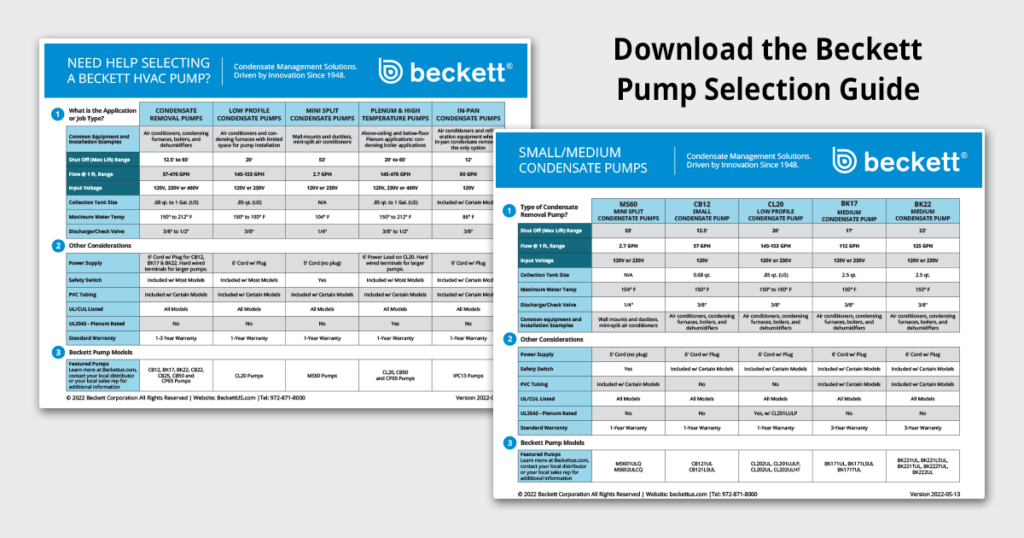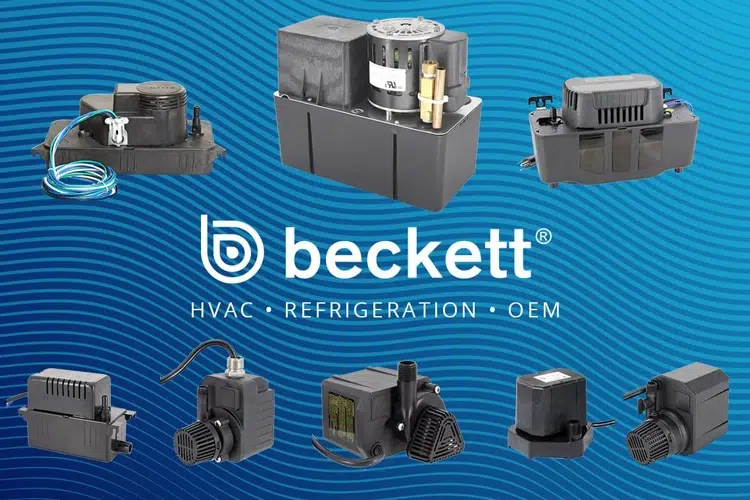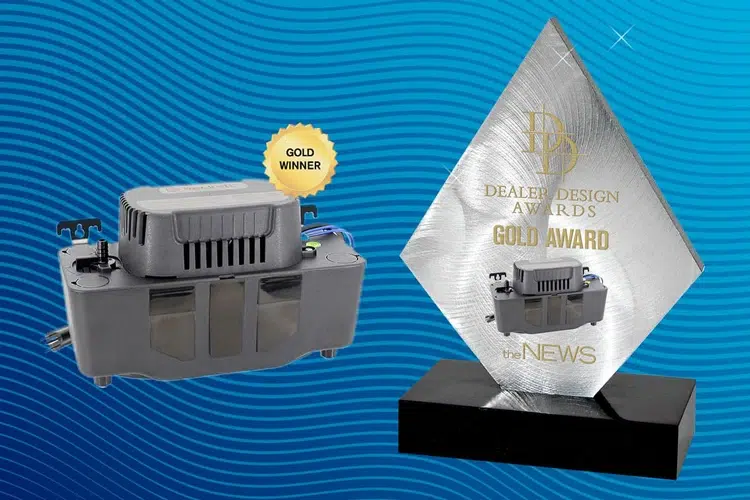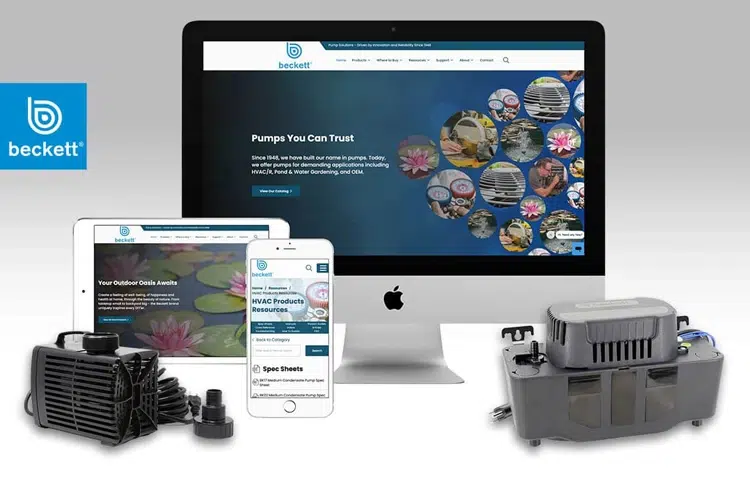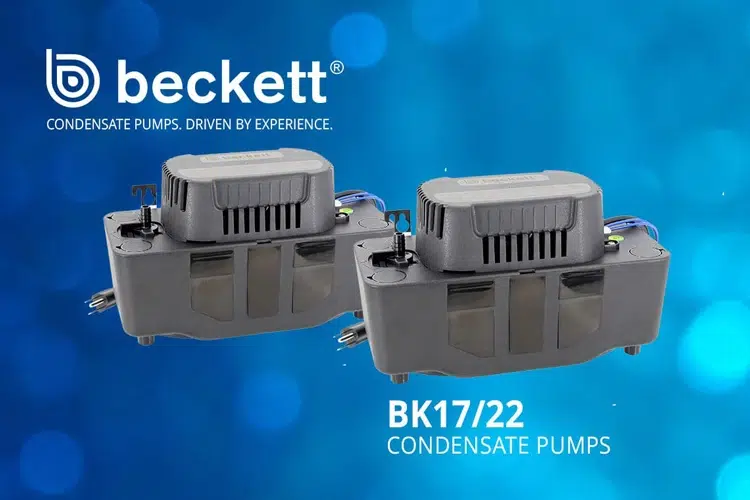5 Easy Steps for Replacing Beckett Condensate Pump

In some cases, replacing condensate pumps can be simple and easy. However, do not oversimplify the complexity of HVAC systems and the potential risks. All condensate pump applications vary and a technically qualified HVAC professional should be consulted to avoid electrical shock, fire hazard, unsatisfactory performance, equipment failure, personal injury, or property damage.
Key Takeaways
- Condensate pumps should only be installed and serviced by technically qualified personnel who are familiar with the correct selection and use of appropriate tools, equipment, and procedures.
- Failure to comply with national and local electrical and plumbing codes and within Beckett Corporation’s recommendations may result in electrical shock or fire hazard, unsatisfactory performance, or equipment failure.
- Know the product’s application, limitations, and potential hazards.
- Read and follow instructions carefully to avoid injury and property damage.
- Do not disassemble or repair the unit unless specifically described in the Beckett user manual for your specific model.
Step 1: Size the Pump to Match the Application
Always review the amount of condensate produced by the HVAC system. Beckett’s BK17 & BK22 series pumps with a 2.5 U.S. quart tank that can handle the typical amount of condensate from a residential HVAC system. However, all systems and applications vary, so please consult an HVAC professional. If you’re replacing an existing pump, you may use the specifications from the old pump to size and select the new condensate pump.
Step 2: What voltage is required for your condensate pump application?
Most residential condensate pumps will operate on 115/120 volts. However, some residential applications may require 230 volts. Depending on the pump model, most Beckett condensate pumps have models are available in 115/120, and 230 volt. Additionally, the Beckett CB50 and CP65 condensate pumps are offered in 115/120, 230, and 460 volt models.
Step 2: Does the selected pump provide adequate lift for the given application?
All condensate pumps are rated for a shutoff point or maximum lift, both measured in feet. It’s important that you carefully determine the total lift required for your application. Total lift is a combination of the maximum lift (peak height above your pump) combined with the length of horizontal* run to your drain point. Once your total lift is determined, compare that requirement to the pump performance data for the pumps you’re considering. See two examples below:
- Example 1: The residential HVAC system is located on the ground floor of a single-story home, the peak lift point is 8′ above the condensate pump, plus a 10′ horizontal run with no slope to the drain point. In this scenario, the total lift needed is 8′, plus another 6″ for the horizontal run equalling 8′ 6″ of total lift. In this case, the Beckett BK171UL series of condensate pumps with a maximum lift of 17 feet would be a good choice.
- Example 2: The residential HVAC system is located in the basement of a 2-story home, the peak lift point is 16′ above the condensate pump to clear the maximum height from the basement, plus a 20′ of horizontal run with no slope to the drain point, equalling 17′ in total lift. In this case, the BK221UL series of condensate pumps with a maximum lift of 22 feet would be a good choice.
*Important Note: An additional application consideration is the length of the horizontal run of the discharge tubing. A general rule of thumb is a loss of 6” of lift for every 10’ of horizontal run for tubing sizes below ½”. This reduction in lift is not a concern after the peak lift point if you can slope the discharge tubing to take advantage of gravity clearing the tubing.
Download the Beckett Pump Selection Guide
Step 3: Locate the Condensate Pump
Beckett BK17 and BK22 series pumps have a 6-foot power cord with a grounded plug, so be sure the pump’s location allows access to a properly grounded receptacle. The pump should be located below the drain pan of the HVAC system so gravity allows a natural flow to the condensate pump inlet. The pump can sit on the floor or be mounted onto the wall using the pump’s mounting tabs. Use the built-in bullseye level or a level to ensure that the pump is installed level as the float switches depend on level water to properly turn on and off.
Step 4: Install Inlet and Discharge Tubing
Beckett’s BK17 and BK22 series pumps have 3 inlet holes on the lid that can be pressed out to best match the installation. Make sure the drain tubing extends past the lid of the pump at least 1” to avoid splashing. Discharge tubing is connected to the 3/8” barb outlet, a hose clamp or zip tie should be used to ensure drip-free operation. It is best to slant the discharge tubing down after the peak so gravity helps clear the tubing. Watch the Beckett 17/22 Condensate Pump features video.
Step 5: Safety Switch (depending on pump model)
Some Beckett condensate pumps include an additional safety switch which is designed to be wired in series to the low voltage thermostat circuit to shut down the source of the condensate water in the event of a pump failure. Using this feature may prevent overflow of the pump. This safety switch can also be wired to an external alarm as a signal that pump flooding is possible.
User Manual
Always reference the included Beckett user manual for safety warnings. Manuals can be found on the product page of our online catalog or on the HVAC Product Resources page.
Installation and Application Warnings
This equipment should only be installed and serviced by technically qualified personnel who are familiar with the correct selection and use of appropriate tools, equipment, and procedures. Failure to comply with national and local electrical and plumbing codes and within Beckett Corp recommendations may result in electrical shock or fire hazard, unsatisfactory performance, or equipment failure. Know the product’s application, limitations, and potential hazards. Read and follow instructions carefully to avoid injury and property damage. Do not disassemble or repair unit unless specifically described in the Beckett user manual for your specific model.
Beckett Customer Service
Although we can provide product support, all applications vary, and it’s strongly recommended that condensate pumps should only be installed and serviced by technically qualified personnel who are familiar with the correct selection and use of appropriate tools, equipment, and procedures in your local area.
For Beckett-specific product questions or support, contact our customer service team or call 866-466-4319 during normal business hours, Monday-Friday, 8:00 to 5:00 Central Time.
